To master herbal tea cupping, you'll need to hone your sensory skills and understand the proper techniques. Start by gathering essential tools like cupping sets, a kettle, and tasting spoons. Select high-quality, fresh herbs and create an ideal tasting environment. Pay attention to brewing methods, including water temperature and steeping times. As you cup, evaluate the tea's appearance, aroma, flavor, and mouthfeel. Learn to identify defects and develop your palate through practice. You can even experiment with creating your own herbal blends. By immersing yourself in this art, you'll uncover a world of nuanced flavors and aromas.
Understanding Herbal Tea Cupping

In light of the growing interest in herbal teas, cupping has emerged as an essential practice for tea enthusiasts and professionals alike. Herbal tea cupping is a systematic method of evaluating and comparing different teas based on their aroma, flavor, and overall quality. It's a skill that allows you to develop a deeper appreciation for the nuances of various herbal blends.
To begin cupping, you'll need a set of identical cups, a kettle, a timer, and a spoon. The process involves steeping multiple teas simultaneously under controlled conditions. You'll assess the dry leaf appearance, inhale the aroma of the wet leaves, and finally taste the brewed tea.
As you cup, you'll focus on key attributes such as fragrance, taste, aftertaste, and mouthfeel. Cupping helps you identify the unique characteristics of each herbal tea, from the floral notes of chamomile to the earthy tones of rooibos.
Essential Tools for Cupping
Five essential tools are crucial for a successful herbal tea cupping session. First, you'll need a cupping set, which typically includes a cupping bowl, a lid, and a saucer. The bowl should be white or light-colored to help you assess the tea's color accurately.
Second, invest in a quality kettle with temperature control, as different herbs require specific brewing temperatures for peak flavor extraction.
Third, procure a timer to guarantee precise steeping times, which can greatly impact the tea's taste and aroma.
Fourth, acquire a set of cupping spoons, specially designed for scooping and tasting the tea without altering its temperature or introducing foreign flavors.
Finally, you'll need a spittoon or disposal vessel for discarding tasted tea between samples.
Additional helpful tools include a scale for measuring tea quantities, a notebook for recording observations, and a flavor wheel to aid in describing taste profiles.
Don't forget to have clean, filtered water on hand, as water quality greatly affects the final cup.
With these tools at your disposal, you'll be well-equipped to conduct professional-level herbal tea cupping sessions and refine your palate.
Selecting Quality Herbal Ingredients
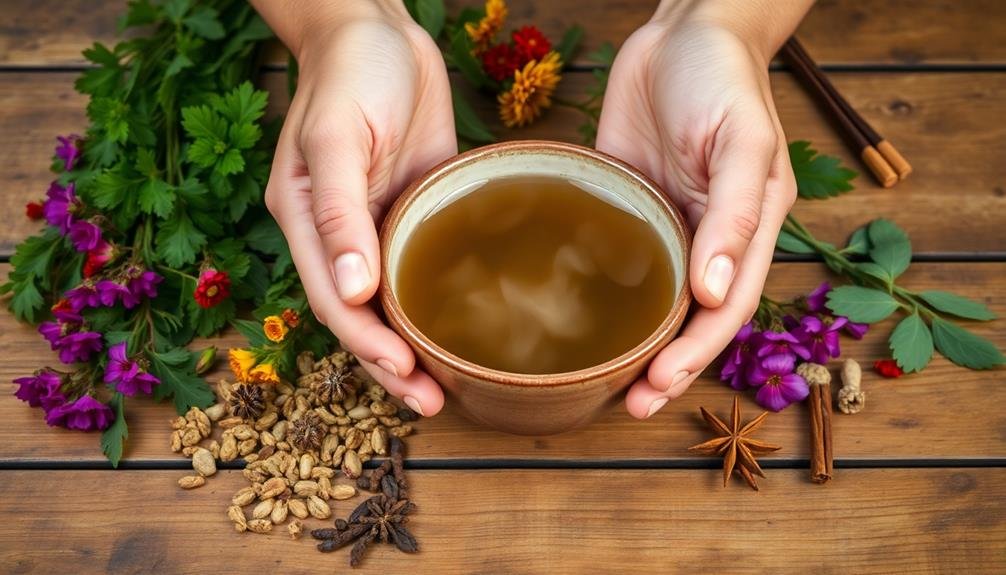
To master herbal tea cupping, you'll need to focus on selecting quality ingredients.
Start by sourcing fresh herbal components from reputable suppliers or your own garden. You can identify high-quality leaves by their vibrant color, intact structure, and aromatic scent.
Once you've obtained your herbs, proper storage techniques, such as using airtight containers and keeping them away from light and moisture, will help maintain their freshness and potency.
Sourcing Fresh Herbal Components
Selecting high-quality herbal ingredients is essential for crafting the perfect herbal tea blend. When sourcing fresh herbal components, you'll want to focus on finding the most vibrant and aromatic options available.
Start by exploring local farmers' markets, where you can often find freshly harvested herbs and flowers. Don't hesitate to ask vendors about their growing practices and harvest dates to guarantee you're getting the freshest ingredients possible.
If you're unable to find what you need locally, consider growing your own herbs. This gives you complete control over the quality and freshness of your ingredients. For those without a green thumb or limited space, online specialty retailers can be a great alternative. Look for suppliers who prioritize freshness and provide detailed information about their sourcing practices.
When selecting your herbal components, keep these key factors in mind:
- Appearance: Look for bright, vibrant colors and intact leaves or petals
- Aroma: Fresh herbs should have a strong, pleasant scent
- Texture: Avoid brittle or dry herbs, which may have lost their potency
- Seasonality: Choose herbs that are in season for the best flavor and medicinal properties
Identifying High-Quality Leaves
Once you've sourced your fresh herbal components, it's time to focus on identifying high-quality leaves. Look for vibrant colors that are typical of the specific herb. Fresh leaves should be free from discoloration, browning, or yellowing. They should feel crisp and sturdy, not limp or wilted.
Examine the leaves closely for any signs of damage, such as holes, tears, or spots. These could indicate pest infestation or disease. The leaves should have a strong, pleasant aroma characteristic of the herb. If they smell musty or off, it's best to avoid them.
Check for uniformity in size and shape, as this often indicates careful harvesting and processing. Avoid leaves with excessive stems or woody parts, as these can affect the flavor of your tea.
For dried herbs, verify they're not overly brittle or powdery, which may suggest they're past their prime.
When possible, taste a small portion of the leaf. It should have a clean, distinct flavor without any bitterness or off-notes.
Proper Storage Techniques
After you've carefully selected your high-quality herbal ingredients, proper storage becomes essential for maintaining their freshness and potency. Storing your herbs correctly guarantees that you'll enjoy the best possible flavor and health benefits when you're ready to brew your tea.
To keep your herbs in prime condition, follow these key storage techniques:
- Use airtight containers
- Store in a cool, dark place
- Keep herbs away from moisture
- Label and date your containers
Choose containers made of glass, ceramic, or food-grade stainless steel to prevent unwanted odors or flavors from seeping into your herbs. Avoid plastic, as it can absorb and transfer flavors.
Place your containers in a pantry or cupboard away from direct sunlight and heat sources, as these can degrade the herbs' quality. Make sure your storage area is dry and well-ventilated to prevent mold growth.
When you're organizing your herb collection, don't forget to clearly label each container with the herb's name and purchase date. This practice helps you keep track of your inventory and use older herbs first.
Preparing the Cupping Environment
To create the ideal herbal tea cupping environment, you'll need to focus on two key aspects: atmosphere and equipment.
Set the mood with soft lighting, comfortable seating, and perhaps some gentle background music to enhance your sensory experience.
Gather essential tools like a kettle, timer, cupping bowls, and spoons, ensuring everything is clean and ready for use.
Setting the Right Atmosphere
Where you set up your herbal tea cupping experience can greatly influence its outcome. Choose a quiet, well-lit space free from distractions and strong odors. Natural light is ideal, but if that's not possible, opt for soft, warm lighting to create a relaxing ambiance. Confirm the room temperature is comfortable, as extreme heat or cold can affect your perception of the tea's flavors and aromas.
Set up your cupping station with all necessary equipment within easy reach. This includes your cupping sets, spoons, timer, and water kettle. Arrange the teas you'll be sampling in a logical order, typically from lightest to darkest or mildest to strongest. Consider using a white tablecloth or placemat to help you assess the tea's color accurately.
To enhance your cupping experience, consider incorporating these elements:
- Soft background music to set a calming mood
- A small notepad and pen for recording your observations
- A palate cleanser, such as plain crackers or water
- A spittoon or disposal cup for discarding tasted tea
Gathering Necessary Equipment
Preparation is key to a successful herbal tea cupping session. You'll need to gather specific equipment to guarantee a proper evaluation of your herbal teas. Start by collecting several identical cupping bowls or cups, preferably white or light-colored to easily observe the tea's color.
You'll also need a set of cupping spoons, which are specially designed for slurping and tasting the tea. A kettle with precise temperature control is vital, as different herbal teas require varying water temperatures. Don't forget a timer to keep track of steeping times.
You'll need a scale to measure tea leaves accurately, guaranteeing consistency across samples. Prepare tasting note sheets and pens for recording your observations. Clean, filtered water is essential for cupping, as tap water can affect the tea's taste.
Have a spittoon or disposal container nearby for discarding tasted tea. Consider having palate cleansers like plain crackers or water between tastings. Finally, gather any reference materials you might need, such as flavor wheels or aroma charts, to help you identify and describe the teas' characteristics accurately.
Proper Brewing Techniques
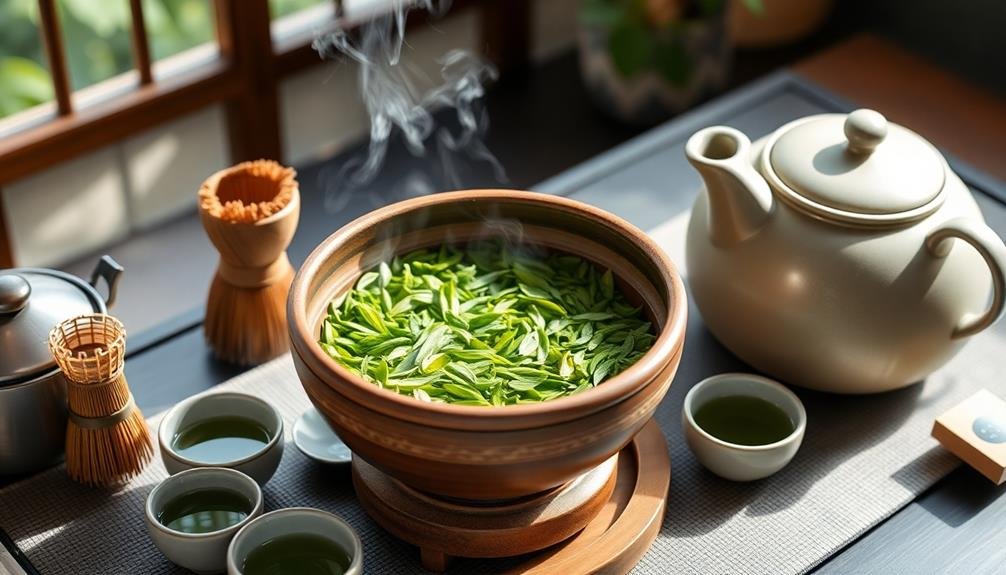
Proper brewing techniques are essential for extracting the full flavor and benefits from your herbal tea. You'll want to pay close attention to water temperature, steeping time, and the ratio of herbs to water. Different herbs require different approaches, so it's imperative to familiarize yourself with the specific needs of each tea variety.
Begin by heating your water to the appropriate temperature. For most herbal teas, you'll want to use water that's just off the boil, around 200°F (93°C).
Once your water is ready, add the correct amount of herbs to your brewing vessel. A general rule of thumb is one teaspoon of dried herbs per cup of water, but this can vary depending on the herb and your personal taste preferences.
Here's a quick guide to steeping times for common herbal teas:
- Chamomile: 5-7 minutes
- Peppermint: 5-7 minutes
- Rooibos: 5-7 minutes
- Hibiscus: 5-10 minutes
Remember to cover your brewing vessel while steeping to prevent the volatile oils from escaping.
Once the steeping time is complete, strain the herbs and enjoy your perfectly brewed cup of herbal tea.
Evaluating Visual Appearance
The visual assessment of your herbal tea provides valuable insights into its quality and preparation. As you examine your brew, pay attention to its color, clarity, and any particles or sediment present.
First, observe the color intensity. A vibrant, rich hue often indicates a well-steeped tea with ample flavor compounds. Pale colors might suggest under-extraction, while overly dark shades could point to over-steeping.
Next, evaluate the tea's clarity. A clear liquid typically signifies proper filtration and handling, while cloudiness may indicate the presence of fine particles or oils from the herbs.
Look for any floating herbs, petals, or leaves. These can add visual appeal but might also affect the tea's texture. Sediment at the bottom of your cup isn't necessarily a flaw; some herbs naturally produce it. However, excessive sediment could mean the tea wasn't strained adequately.
Assessing Aroma Profiles
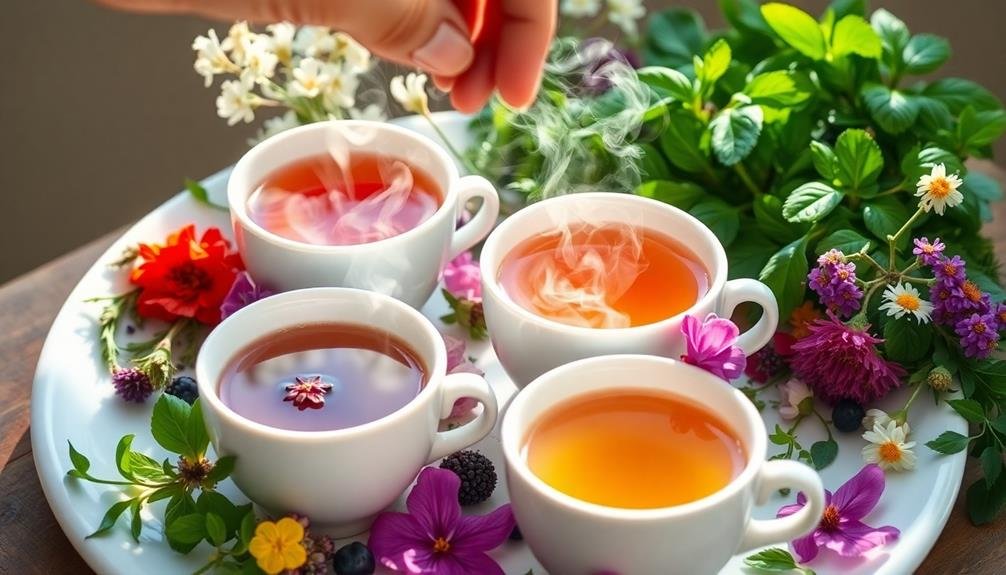
A symphony of scents awaits as you assess your herbal tea's aroma profile. This step is essential in understanding the tea's character and quality. To properly evaluate the aroma, you'll need to engage your olfactory senses fully.
Start by gently swirling the brewed tea in your cup to release its volatile compounds. Then, bring the cup close to your nose and take several short, sharp sniffs.
As you inhale, focus on identifying the different aromatic notes present in the tea. These can range from floral and fruity to earthy and spicy. Pay attention to how the scents evolve and interact with each other. Remember that a well-crafted herbal tea should have a balanced and harmonious aroma profile.
To help you categorize and describe the aromas you encounter, consider these common scent categories:
- Floral (e.g., lavender, jasmine, rose)
- Fruity (e.g., citrus, berry, stone fruit)
- Herbal (e.g., mint, chamomile, sage)
- Spicy (e.g., cinnamon, ginger, cardamom)
Tasting and Flavor Analysis
Once you've assessed the aroma, it's time to plunge into the tasting and flavor analysis of your herbal tea. Take a small sip and let it coat your tongue. Pay attention to the initial taste, as it'll often differ from the finish.
Note the tea's body – is it light and delicate or full and robust? Identify the primary flavors you're experiencing. Is it floral, fruity, earthy, or spicy? Look for secondary and tertiary notes that add complexity.
Consider the tea's sweetness, bitterness, or astringency. These elements contribute to the overall balance of the brew. As you swallow, focus on the aftertaste. Does it linger pleasantly, or does it dissipate quickly? Some teas leave a lasting impression, while others are more ephemeral.
Try to pinpoint specific flavor notes. For example, you might detect hints of chamomile, lavender, or mint. Don't be afraid to use unconventional descriptors – if a flavor reminds you of a specific memory or place, incorporate that into your analysis.
Identifying Texture and Mouthfeel
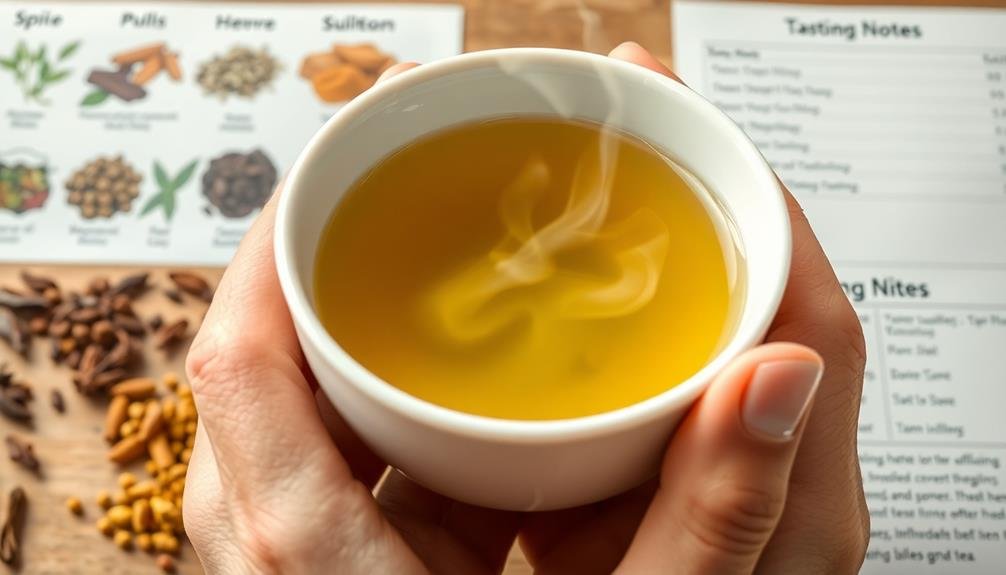
Texture and mouthfeel are two essential aspects of herbal tea that often go overlooked. As you cup herbal teas, you'll want to pay close attention to how the liquid feels in your mouth. Is it smooth or astringent? Does it leave a lingering sensation? These qualities can greatly impact your overall enjoyment of the tea.
To identify texture and mouthfeel, take a small sip and let it coat your tongue and palate. Focus on the sensations you experience. Here's what to look for:
- Body: Is the tea light and delicate, or full-bodied and robust?
- Astringency: Do you feel a drying sensation in your mouth?
- Smoothness: Does the tea glide effortlessly across your palate?
- Viscosity: Is the liquid thin and watery, or thick and syrupy?
Remember that different herbs can contribute unique textures. For example, marshmallow root adds a silky smoothness, while hibiscus can create a slight tartness and astringency.
As you practice, you'll develop a keen sense for these subtle differences. Don't hesitate to compare different teas side by side to sharpen your ability to distinguish various textures and mouthfeels.
Recognizing Herbal Tea Defects
While mastering the art of identifying texture and mouthfeel enhances your appreciation for quality herbal teas, it's equally important to recognize potential defects. Common defects you'll encounter include staleness, off-flavors, and contamination.
To detect staleness, pay attention to a lack of aroma or a flat taste. Fresh herbal teas should have vibrant scents and flavors. If you notice a musty or cardboard-like smell, it's likely the tea has absorbed moisture or been stored improperly.
Off-flavors can result from various factors. Look out for sour notes, which may indicate fermentation or spoilage. Bitter or astringent tastes that overpower the tea's natural profile could suggest over-steeping or using water that's too hot.
Contamination is a serious concern. Inspect your tea for any visible mold, insects, or foreign particles. If you detect chemical odors or tastes, it may indicate pesticide residue or improper processing.
Train your palate to identify these defects by comparing high-quality teas with intentionally flawed samples. This practice will sharpen your ability to discern between acceptable variations and true defects, ensuring you always enjoy the best herbal tea experience.
Developing Your Palate
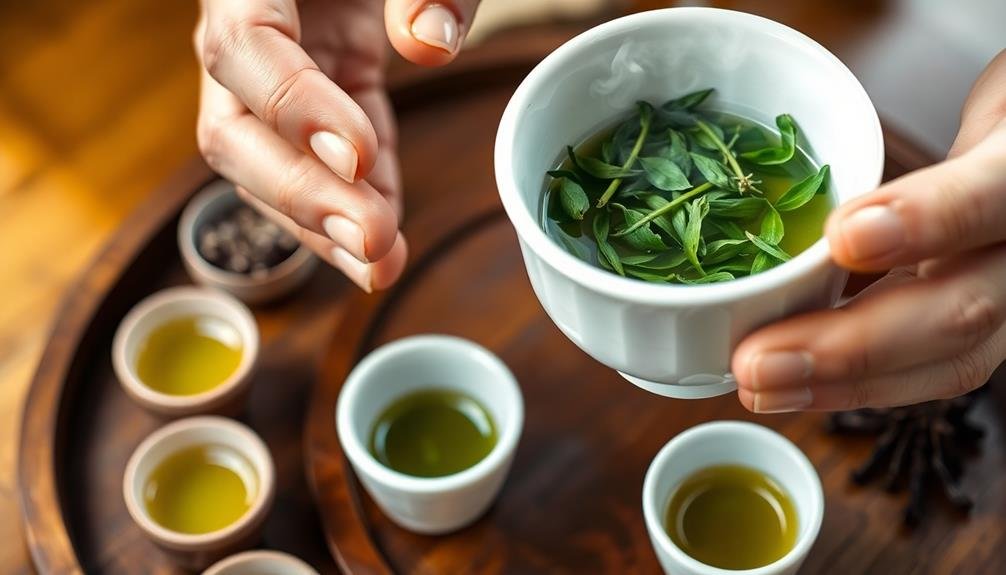
Developing your palate for herbal tea cupping is an essential skill you can cultivate with practice.
You'll want to train your taste buds by sampling a wide variety of herbal teas and consciously noting their unique flavor profiles.
As you explore different blends, practice mindful tasting techniques to heighten your awareness of subtle taste nuances and aromatic complexities.
Train Your Taste Buds
Honing your palate is an essential step in becoming a true herbal tea connoisseur. To train your taste buds effectively, you'll need to practice regularly and pay close attention to the nuances of each tea you sample.
Start by tasting a variety of herbal teas, focusing on their individual flavor profiles, aromas, and textures. As you progress, challenge yourself to identify specific ingredients and their contributions to the overall taste.
Don't hesitate to compare different brands or blends of the same type of herbal tea to refine your ability to discern subtle differences.
To enhance your tasting skills, try these techniques:
- Cleanse your palate between tastings with water or plain crackers
- Take small sips and let the tea coat your entire mouth
- Practice describing flavors using specific terms like "earthy," "floral," or "citrusy"
- Keep a tasting journal to track your observations and progress
Explore Flavor Profiles
As you become more adept at tasting herbal teas, it's time to explore the vast array of flavor profiles available. Start by categorizing teas into broad flavor groups: floral, fruity, spicy, earthy, and herbal. Within each category, you'll find nuanced differences to discover.
For floral teas, compare the delicate notes of chamomile to the more robust flavors of lavender or rose. In fruity blends, distinguish between the tartness of hibiscus and the sweetness of berry-infused teas. Spicy teas offer a range from the warmth of cinnamon to the bite of ginger or peppermint.
Earthy teas like rooibos or yerba mate have distinct mineral qualities, while herbal blends can range from grassy to vegetal. Pay attention to the mouthfeel of each tea, noting whether it's light and crisp or full-bodied and smooth.
As you explore, create a flavor wheel or tasting journal to record your observations. This will help you identify preferences and develop a more sophisticated palate.
Don't hesitate to try unconventional combinations or lesser-known herbs to expand your flavor vocabulary and deepen your appreciation for herbal teas.
Practice Mindful Tasting
Mindful tasting is the key to revealing the full potential of your herbal tea experience. By focusing your attention on each sip, you'll uncover nuances and complexities that might otherwise go unnoticed.
To practice mindful tasting, start by finding a quiet, comfortable space where you can fully concentrate on your tea.
As you sip, pay attention to these aspects:
- Temperature: Notice how the warmth affects your perception of flavor.
- Aroma: Inhale deeply and identify the scents that reach your nose.
- Mouthfeel: Observe the tea's texture and how it coats your tongue.
- Aftertaste: Be aware of the lingering flavors after you've swallowed.
Take small sips and let the tea roll over your tongue, allowing it to reach all areas of your mouth.
Try to identify individual flavors and how they interact with each other. Don't rush the process; instead, savor each moment and let the tea's characteristics unfold gradually.
With practice, you'll develop a more refined palate and a deeper appreciation for the subtle differences between various herbal teas.
Creating Customized Herbal Blends
Creating your own herbal tea blends is an exciting way to personalize your cupping experience. Start by selecting a base herb, such as chamomile, peppermint, or rooibos, which will form the foundation of your blend.
Next, choose complementary herbs that enhance the flavor profile and offer additional health benefits. Consider using aromatic herbs like lavender or lemon balm for a soothing blend, or add ginger or cinnamon for a spicier mix.
Experiment with different ratios to find the perfect balance of flavors. Begin with a 2:1 ratio of base herb to complementary herbs, and adjust as needed.
Don't forget to include herbs that add visual appeal, such as rose petals or cornflower blossoms. Keep a journal to record your blends and tasting notes, allowing you to refine your recipes over time.
When creating medicinal blends, research the properties of each herb and verify they're safe to combine. Always consult a healthcare professional before using herbal teas for medicinal purposes.
As you become more confident in your blending skills, you'll develop signature blends that reflect your personal taste and wellness goals.
Frequently Asked Questions
Can Herbal Tea Cupping Help With Identifying Medicinal Properties of Herbs?
Yes, herbal tea cupping can help you identify medicinal properties of herbs. You'll learn to discern subtle flavors, aromas, and effects, which can indicate potential health benefits. It's a valuable skill for understanding herbal remedies.
How Long Does It Take to Become Proficient in Herbal Tea Cupping?
You'll need about 6-12 months of consistent practice to become proficient in herbal tea cupping. It's a skill that requires patience and dedication. You'll improve faster if you're tasting teas regularly and learning from experts.
Are There Any Health Risks Associated With Frequent Herbal Tea Cupping?
While generally safe, frequent herbal tea cupping can pose risks if you're not careful. You might experience allergic reactions, interact with medications, or consume excessive amounts of certain herbs. It's best to consult a healthcare professional for personalized advice.
Can Herbal Tea Cupping Techniques Be Applied to Other Beverages?
Yes, you can apply cupping techniques to other beverages. You'll find they work well with coffee, wine, and even some spirits. It's a versatile method that enhances your sensory experience across various drinks. Give it a try!
What Career Opportunities Are Available for Skilled Herbal Tea Cuppers?
As a skilled herbal tea cupper, you'll find opportunities in tea shops, specialty cafes, and tea companies. You can become a tea buyer, flavor developer, or quality control specialist. Consider teaching workshops or starting your own tea consultancy business.
In Summary
You've now learned the essentials of herbal tea cupping. With practice, you'll refine your skills in selecting ingredients, brewing techniques, and sensory evaluation. Don't be afraid to experiment with custom blends and trust your developing palate. Remember, cupping is both an art and a science. As you continue to explore the world of herbal teas, you'll discover new flavors and deepen your appreciation for this ancient beverage. Keep sipping and enjoy the journey!

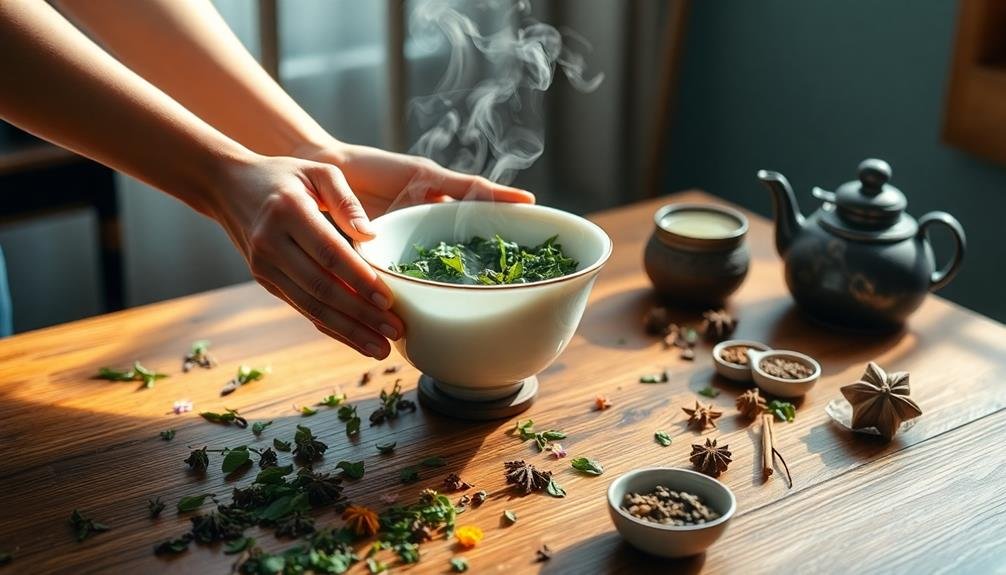



Leave a Reply